Sparse Autoencoder(一)
Neural Networks
We will use the following diagram to denote a single neuron:
This "neuron" is a computational unit that takes as input x1,x2,x3 (and a +1 intercept term), and outputs
, where
is called the activation function. In these notes, we will choose
to be the sigmoid function:
Thus, our single neuron corresponds exactly to the input-output mapping defined by logistic regression.
Although these notes will use the sigmoid function, it is worth noting that another common choice for f is the hyperbolic tangent, or tanh, function:
Here are plots of the sigmoid and tanh functions:
Finally, one identity that'll be useful later: If f(z) = 1 / (1 + exp( − z)) is the sigmoid function, then its derivative is given by f'(z) = f(z)(1 − f(z))
sigmoid 函数 或 tanh 函数都可用来完成非线性映射
Neural Network model
A neural network is put together by hooking together many of our simple "neurons," so that the output of a neuron can be the input of another. For example, here is a small neural network:
In this figure, we have used circles to also denote the inputs to the network. The circles labeled "+1" are called bias units, and correspond to the intercept term. The leftmost layer of the network is called the input layer, and the rightmost layer the output layer (which, in this example, has only one node). The middle layer of nodes is called the hidden layer, because its values are not observed in the training set. We also say that our example neural network has 3 input units (not counting the bias unit), 3 hidden units, and 1 output unit.
Our neural network has parameters (W,b) = (W(1),b(1),W(2),b(2)), where we write
to denote the parameter (or weight) associated with the connection between unit j in layer l, and unit i in layerl + 1. (Note the order of the indices.) Also,
is the bias associated with unit i in layer l + 1.
We will write
to denote the activation (meaning output value) of unit i in layer l. For l = 1, we also use
to denote the i-th input. Given a fixed setting of the parameters W,b, our neural network defines a hypothesis hW,b(x) that outputs a real number. Specifically, the computation that this neural network represents is given by:
每层都是线性组合 + 非线性映射
In the sequel, we also let
denote the total weighted sum of inputs to unit i in layer l, including the bias term (e.g.,
), so that
.
Note that this easily lends itself to a more compact notation. Specifically, if we extend the activation function
to apply to vectors in an element-wise fashion (i.e., f([z1,z2,z3]) = [f(z1),f(z2),f(z3)]), then we can write the equations above more compactly as:
We call this step forward propagation.
Backpropagation Algorithm
for a single training example (x,y), we define the cost function with respect to that single example to be:
This is a (one-half) squared-error cost function. Given a training set of m examples, we then define the overall cost function to be:
J(W,b;x,y) is the squared error cost with respect to a single example; J(W,b) is the overall cost function, which includes the weight decay term.
Our goal is to minimize J(W,b) as a function of W and b. To train our neural network, we will initialize each parameter
and each
to a small random value near zero (say according to a Normal(0,ε2) distribution for some small ε, say 0.01), and then apply an optimization algorithm such as batch gradient descent.Finally, note that it is important to initialize the parameters randomly, rather than to all 0's. If all the parameters start off at identical values, then all the hidden layer units will end up learning the same function of the input (more formally,
will be the same for all values of i, so that
for any input x). The random initialization serves the purpose of symmetry breaking.
One iteration of gradient descent updates the parameters W,b as follows:
The two lines above differ slightly because weight decay is applied to W but not b.
The intuition behind the backpropagation algorithm is as follows. Given a training example (x,y), we will first run a "forward pass" to compute all the activations throughout the network, including the output value of the hypothesis hW,b(x). Then, for each node i in layer l, we would like to compute an "error term"
that measures how much that node was "responsible" for any errors in our output.
For an output node, we can directly measure the difference between the network's activation and the true target value, and use that to define
(where layer nl is the output layer). For hidden units, we will compute
based on a weighted average of the error terms of the nodes that uses
as an input. In detail, here is the backpropagation algorithm:
- 1,Perform a feedforward pass, computing the activations for layers L2, L3, and so on up to the output layer
.
2,For each output unit i in layer nl (the output layer), set
For
For each node i in layer l, set
4,Compute the desired partial derivatives, which are given as:
We will use "
" to denote the element-wise product operator (denoted ".*" in Matlab or Octave, and also called the Hadamard product), so that if
, then
. Similar to how we extended the definition of
to apply element-wise to vectors, we also do the same for
(so that
).
The algorithm can then be written:
- 1,Perform a feedforward pass, computing the activations for layers
,
, up to the output layer
, using the equations defining the forward propagation steps
2,For the output layer (layer
), set
3,For
- Set
4,Compute the desired partial derivatives:
Implementation note: In steps 2 and 3 above, we need to compute
for each value of
. Assuming
is the sigmoid activation function, we would already have
stored away from the forward pass through the network. Thus, using the expression that we worked out earlier for
, we can compute this as
.
Finally, we are ready to describe the full gradient descent algorithm. In the pseudo-code below,
is a matrix (of the same dimension as
), and
is a vector (of the same dimension as
). Note that in this notation, "
" is a matrix, and in particular it isn't "
times
." We implement one iteration of batch gradient descent as follows:
- 1,Set
,
(matrix/vector of zeros) for all
.
- 2,For
to
,
- Use backpropagation to compute
and
.
- Set
.
- Set
.
- 3,Update the parameters:



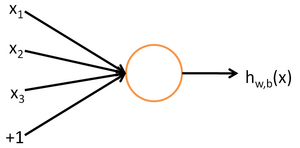
 , where
, where  is called the activation function. In these notes, we will choose
is called the activation function. In these notes, we will choose  to be the sigmoid function:
to be the sigmoid function:

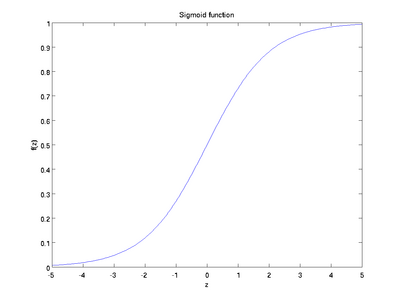
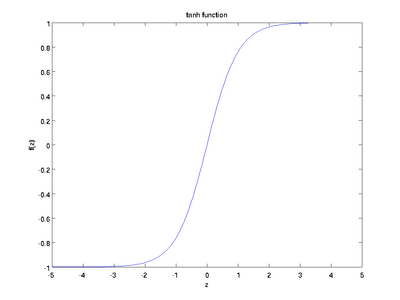
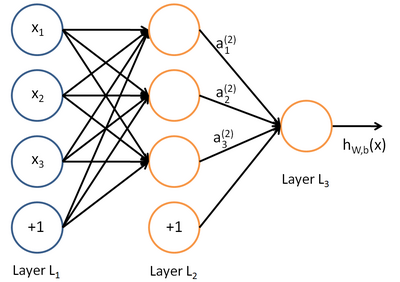
 to denote the parameter (or weight) associated with the connection between unit j in layer l, and unit i in layerl + 1. (Note the order of the indices.) Also,
to denote the parameter (or weight) associated with the connection between unit j in layer l, and unit i in layerl + 1. (Note the order of the indices.) Also,  is the bias associated with unit i in layer l + 1.
is the bias associated with unit i in layer l + 1. to denote the activation (meaning output value) of unit i in layer l. For l = 1, we also use
to denote the activation (meaning output value) of unit i in layer l. For l = 1, we also use  to denote the i-th input. Given a fixed setting of the parameters W,b, our neural network defines a hypothesis hW,b(x) that outputs a real number. Specifically, the computation that this neural network represents is given by:
to denote the i-th input. Given a fixed setting of the parameters W,b, our neural network defines a hypothesis hW,b(x) that outputs a real number. Specifically, the computation that this neural network represents is given by:
 denote the total weighted sum of inputs to unit i in layer l, including the bias term (e.g.,
denote the total weighted sum of inputs to unit i in layer l, including the bias term (e.g.,  ), so that
), so that  .
.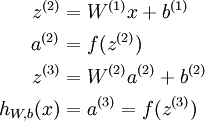

![\begin{align}
J(W,b)
&= \left[ \frac{1}{m} \sum_{i=1}^m J(W,b;x^{(i)},y^{(i)}) \right]
+ \frac{\lambda}{2} \sum_{l=1}^{n_l-1} \; \sum_{i=1}^{s_l} \; \sum_{j=1}^{s_{l+1}} \left( W^{(l)}_{ji} \right)^2
\\
&= \left[ \frac{1}{m} \sum_{i=1}^m \left( \frac{1}{2} \left\| h_{W,b}(x^{(i)}) - y^{(i)} \right\|^2 \right) \right]
+ \frac{\lambda}{2} \sum_{l=1}^{n_l-1} \; \sum_{i=1}^{s_l} \; \sum_{j=1}^{s_{l+1}} \left( W^{(l)}_{ji} \right)^2
\end{align}](http://deeplearning.stanford.edu/wiki/images/math/4/5/3/4539f5f00edca977011089b902670513.png)
 will be the same for all values of i, so that
will be the same for all values of i, so that  for any input x). The random initialization serves the purpose of symmetry breaking.
for any input x). The random initialization serves the purpose of symmetry breaking.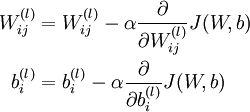
![\begin{align}
\frac{\partial}{\partial W_{ij}^{(l)}} J(W,b) &=
\left[ \frac{1}{m} \sum_{i=1}^m \frac{\partial}{\partial W_{ij}^{(l)}} J(W,b; x^{(i)}, y^{(i)}) \right] + \lambda W_{ij}^{(l)} \\
\frac{\partial}{\partial b_{i}^{(l)}} J(W,b) &=
\frac{1}{m}\sum_{i=1}^m \frac{\partial}{\partial b_{i}^{(l)}} J(W,b; x^{(i)}, y^{(i)})
\end{align}](http://deeplearning.stanford.edu/wiki/images/math/9/3/3/93367cceb154c392aa7f3e0f5684a495.png)
 that measures how much that node was "responsible" for any errors in our output.
that measures how much that node was "responsible" for any errors in our output. (where layer nl is the output layer). For hidden units, we will compute
(where layer nl is the output layer). For hidden units, we will compute  .
.


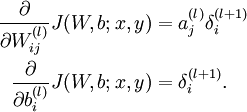
 " to denote the element-wise product operator (denoted ".*" in Matlab or Octave, and also called the Hadamard product), so that if
" to denote the element-wise product operator (denoted ".*" in Matlab or Octave, and also called the Hadamard product), so that if  , then
, then  . Similar to how we extended the definition of
. Similar to how we extended the definition of  to apply element-wise to vectors, we also do the same for
to apply element-wise to vectors, we also do the same for  (so that
(so that ![\textstyle f'([z_1, z_2, z_3]) =
[f'(z_1),
f'(z_2),
f'(z_3)]](http://deeplearning.stanford.edu/wiki/images/math/c/7/5/c7515c53b59e670ceee277e06c1229cb.png) ).
). ,
,  , up to the output layer
, up to the output layer  , using the equations defining the forward propagation steps
, using the equations defining the forward propagation steps ), set
), set



 for each value of
for each value of  . Assuming
. Assuming  is the sigmoid activation function, we would already have
is the sigmoid activation function, we would already have  stored away from the forward pass through the network. Thus, using the expression that we worked out earlier for
stored away from the forward pass through the network. Thus, using the expression that we worked out earlier for  , we can compute this as
, we can compute this as  .
. is a matrix (of the same dimension as
is a matrix (of the same dimension as  ), and
), and  is a vector (of the same dimension as
is a vector (of the same dimension as  ). Note that in this notation, "
). Note that in this notation, " times
times  ,
,  (matrix/vector of zeros) for all
(matrix/vector of zeros) for all  .
. to
to  ,
, and
and  .
. .
. .
.![\begin{align}
W^{(l)} &= W^{(l)} - \alpha \left[ \left(\frac{1}{m} \Delta W^{(l)} \right) + \lambda W^{(l)}\right] \\
b^{(l)} &= b^{(l)} - \alpha \left[\frac{1}{m} \Delta b^{(l)}\right]
\end{align}](http://deeplearning.stanford.edu/wiki/images/math/0/f/7/0f7430e97ec4df1bfc56357d1485405f.png)

 浙公网安备 33010602011771号
浙公网安备 33010602011771号